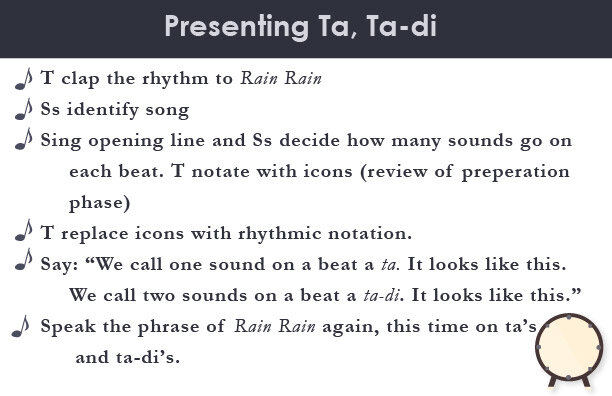Grade 1 Rhythm: Quarter Eighth Note lessons with sheet music, printables, and more!
Ta, Ti-Ti
Ta, Ta-di
Crotchets, Quavers
1, 2-and
Pear, Apple
Quarter and eighth notes go by a lot of names... and they can be taught in just as many ways as there are names for them.
Regardless of which names we call these little guys, if students can keep a steady beat and tell the difference between beat and rhythm, they're ready to learn!
Let's sing, play, and dance our way through the prepare present practice sequence!
Preparing quarter and eighth notes
Aural
Students need to be able to hear that there are two sounds on one beat for eighth notes. To help them with this, pick one of the songs from this post (or your own favorite quarter eighth note song!) and sing it as a group while your students keep the steady beat. Isolate one phrase and sing it while the class pats a steady beat. How many times did they pat as you sang? How many sounds did they hear on the third beat? First beat?
Physical
Playing a quarter eighth note ostinato ensures that students are engraining the physical motion of ta ta-di since they play it over and over (and over and over and over).
For example, use a simple ostinato such as "shoe, cobbler, shoe, shoe" or another variation for the song Cobbler Cobbler. Students can clap or take turns playing it on woodblocks or rhythm sticks while the rest of the class sings the song
Visual
By this point students have progressed from reading icons over hearts to icons over horizontal lines to represent the beat. Isolate one phrase from a known song, such as Cobbler Cobbler, and ask students to notate it with partners. Popsicle sticks and some small icons work well for this.
Presenting quarter and eighth notes
After enough time preparing quarter and eighth notes, it's time to present!
Follow a script similar to this:
Practicing Quarter and Eighth Notes
Aural
Dictation is n amazing way to practice whether or not students can hear the subdivision of the big beat (quarter notes) into smaller sounds (eighth notes). They've already been doing this in the preparation phase with icons, so in the practice phase we simply replace the icons with standard notation for quarter and eighth notes.
Physical
Another way to build upon the preparation phase is for students to compose their own ostinati for a simple song like Cobbler Cobbler. Have students come up with a combination of "cobbler" and "shoe" that takes up four beats. Write the rhythmic notation on the board and then sing the song with students taking turns playing the ostinato they created.
Visual
Similar to what we did in this post, choose a collection of songs and write the names on the board. Then write the opening rhythm to one of the songs on the board and clap it with the class. Can they guess what song they were clapping?
This exercise gets more interesting when you have students clap the opening line to a song they don't yet know. It's a nice way to practice rhythm and introduce a new song at the same time!
You can also use this worksheet to have them match phrases of songs they already know to the new rhythmic notation.
It's free! Just click to download.
Happy teaching!









